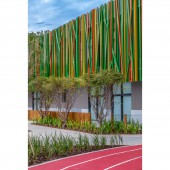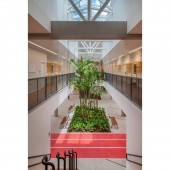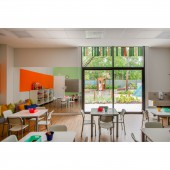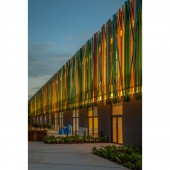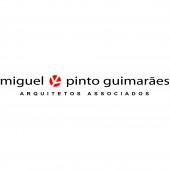Eleva School by Miguel Pinto Guimaraes |
Home > Winners > #80777 |
 |
|
||||
| DESIGN DETAILS | |||||
| DESIGN NAME: Eleva PRIMARY FUNCTION: School INSPIRATION: The external skin that overlay the entire building was projected to reduce the incidence of sunlight on the east and west facades by 50 percent. Its design also has an ecological and educational character, since it reflects the original ecosystem of the region based of swamp and mangrove. The elaborated facade project offers a interpretation of this vegetation characteristic emerged roots. The chosen collor palette respects the natural chromatic variety of this type of vegetation. UNIQUE PROPERTIES / PROJECT DESCRIPTION: Eleva School site Barra is the second unit of an important network of schools in Rio de Janeiro. The project is adapting a fairly horizontal commercial building to receive the school's program. The project starts from eliminating significant area of the ground floor of the largest existing building a great covered patio. It becomes the circulation and distribution hub of the school, a new axis that connects all the landscaping areas of the complex, with the aide of a central internal garden. OPERATION / FLOW / INTERACTION: One of the biggest challenge for the project was the presence of the main block of the existing building to be renovated, which was an obstacle to the movement of people, ventilation and especially for the view. An obstacle to induce a sensory domain of the whole site, dividing it into several smaller areas with no connection or dialogue one to each other. PROJECT DURATION AND LOCATION: The project began in August 2017. In December 2017, the construction began with a duration of 14 months. In February 2019 the school was inaugurated at the beginning of the Brazilian school year. The school is located in the neighborhood of Barra da Tijuca, in the western zone of Rio de Janeiro. FITS BEST INTO CATEGORY: Architecture, Building and Structure Design |
PRODUCTION / REALIZATION TECHNOLOGY: Some attention was taken in planning this landscape. Large trees were used to contribute to the shading of the facades. Mostly east and west. The choice of fruit trees was suggested for the attraction of fauna. Plants of the local flora were specified, many succulents and species resistant to drought in order to avoid the water consumption required to maintain other species. In the outer sports courts, the use of synthetic grass was proposed. All pathways are made with drainage materials. SPECIFICATIONS / TECHNICAL PROPERTIES: Site area: 16.795,83m² Construction area: 10.482,35m² TAGS: School Design, Suistantable School, Building Renovation, School Landscape, Architectural Skin RESEARCH ABSTRACT: The research began by studying similar educational buildings, mainly in relation to safety and sustainability. A study of native plant species was also carried out. We chose to use plants that needed little water for a sustainable issue. Natural lighting through the creation of light-shelves were also issues studied. CHALLENGE: Another challenge was to minimize the effects of bad orientation of the existent buildings. Its facades are oriented to east and west. To the west it receives the afternoon sun, having its greater thermal effect between 15:30 and 16hs. This is exactly what should be avoided in any minimally sustainable project. The east facade receives the sun throughout the morning. In the case of the school, which is equally damaging. To minimize this problem, a skin enveloping the entire building was proposed. ADDED DATE: 2019-02-27 19:30:00 TEAM MEMBERS (14) : Miguel Pinto Guimarães, Renata Duhá, Adriana Moura, Rafael Amorim, Teresa Jardim, Natália Lopes, Tati Viany, Daniela Monteiro, Aline Soares, Aline Almeida, Helena Costa, Cesar Rodrigues, Roberta Lopes and Victoria Leon IMAGE CREDITS: Image #1: Photographer Andre Nazareth Image #2: Photographer Andre Nazareth Image #3: Photographer Andre Nazareth Image #4: Photographer Andre Nazareth Image #5: Photographer Andre Nazareth Video Credits: Domus Arquitetura Digital Contemporânea |
||||
| Visit the following page to learn more: http://bit.ly/2IFv5Hl | |||||
| AWARD DETAILS | |
 |
Eleva School by Miguel Pinto Guimaraes is Winner in Architecture, Building and Structure Design Category, 2018 - 2019.· Press Members: Login or Register to request an exclusive interview with Miguel Pinto Guimaraes. · Click here to register inorder to view the profile and other works by Miguel Pinto Guimaraes. |
| SOCIAL |
| + Add to Likes / Favorites | Send to My Email | Comment | Testimonials | View Press-Release | Press Kit |

